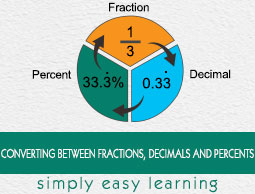
- Converting Between Fractions, Decimals, and Percents
- Home
- Converting a Fraction with a Denominator of 100 to a Percentage
- Converting a Percentage to a Fraction with a Denominator of 100
- Finding the Percentage of a Grid that is Shaded
- Representing Benchmark Percentages on a Grid
- Introduction to Converting a Percentage to a Decimal
- Introduction to Converting a Decimal to a Percentage
- Converting Between Percentages and Decimals
- Converting Between Percentages and Decimals in a Real-World Situation
- Converting a Percentage to a Fraction in Simplest Form
- Converting a Fraction to a Percentage: Denominator of 4, 5, or 10
- Finding Benchmark Fractions and Percentages for a Figure
- Converting a Fraction to a Percentage: Denominator of 20, 25, or 50
- Converting a Fraction to a Percentage in a Real-World Situation
Introduction to Converting a Percentage to a Decimal
Introduction
As per the definition of a percentage, the percentage of a number x, x% = $\frac{x}{100}$
To convert this percentage to a decimal, we write it as a fraction and there is 100 in the denominator. To replace 100, we shift the decimal point two places to the left to get the decimal.
Rules to convert a percentage to a decimal
-
First, we write the percentage with a decimal point.
For example, 12% = 12.0%
-
Then shift the decimal point two places to the left.
For example, 0.12%
-
Then we drop the percentage sign.
For example, 0.12. So, 12% = 0.12
Formula
By definition of a per cent, for any whole number x, x% = $\frac{x}{100}$ = 0.0x For example: 5% = $\frac{5}{100}$ = 0.05
Example 1
Convert the following percentage to a decimal
72%
Solution
Step 1:
By definition of a per cent, for any whole number x, x% = $\frac{x}{100}$ = 0.0x
Step 2:
The decimal point is shifted two places to the left and the percent sign is dropped.
So, 72% = 72.0% = 0.72
Example 2
Convert the following percentage to a decimal
256%
Solution
Step 1:
By definition of a per cent, for any whole number x, x% = $\frac{x}{100}$ = 0.0x
Step 2:
The decimal point is shifted two places to the left and the percent sign is dropped.
So, 256% = 256.0% = 2.56
Example 3
Convert the following percentage to a decimal
8%
Solution
Step 1:
By definition of a per cent, for any whole number x, x% = $\frac{x}{100}$ = 0.0x
Step 2:
The decimal point is shifted two places to the left and the percent sign is dropped.
So, 8% = 8.0% = 0.08